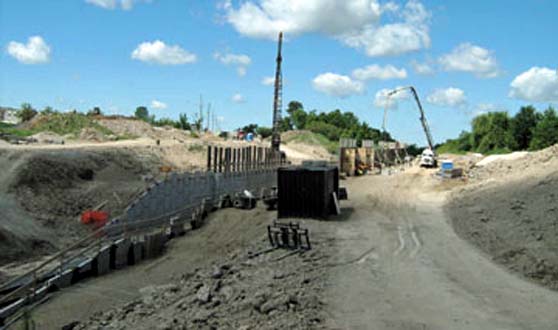
2011
|


Sarnia Road in London, Ontario, looking west showing piling and decorative RSS wall
adjacent to CPR track (below left) with piers and north abutment wall in background. |
26 August 2011
Overpass Construction in London Ontario Replaces One-Lane Rail Bridge
London Ontario - Removing an antiquated rail bridge in an increasingly growing part of northwest London is key to opening up the area
to greater development.
The $11.5 million project to replace the Canadian Pacific Railway bridge, which was built in the 1890s and installed on Sarnia Road in 1909, and to widen part
of Sarnia Road to four lanes, is one of the city's largest road works this summer.
East-west Sarnia Road has been acknowledged as an increasingly important connector of suburban subdivisions to north-south Wonderland Road North to the east
near the University of Western Ontario, and which runs south towards the city centre.
But Sarnia Road's four lanes ended only a couple of hundred metres west of Wonderland at the entrance of a subdivision at Aldersbrook Rd. Further west for
about a kilometre the road was two lanes. It then abruptly became one lane over the CPR truss bridge. That caused significant traffic bottlenecks. Further west
for a couple of kilometres the road also was two lanes until it reached the next major north-south artery, Hyde Park Road.
The truss bridge itself was a symbol of the area's rural roots. It was angled at 90 degrees to Sarnia Road and east-west traffic had to stop and take turns
using it. But Sarnia Road, which still traverses a semi-rural area, at last count had as many as 6,500 vehicles a day.
The bridge had "no allowance for commercial vehicles to cross due to alignment and load restrictions," city engineer Ted Koza said. "Since 2007,
trucks have struck the bridge twice, forcing the closure of Sarnia Road for a total of five months."
The current project began in April and winds up in late October. It includes removal of the old bridge and construction of a new four lane overpass above the
single track CPR main line to Windsor. Sarnia Road will continue with four lanes half a kilometre to another subdivision at Beaverbrook Rd.
Dillon Consulting Limited's project manager Jason Johnson said the widening is part of a "sequence" of road improvements over the next few years that
will see the remainder of Sarnia Road reconstructed west to Hyde Park Road.
The current rehabilitation includes street lighting, bike lanes, sidewalks on both sides of the road, and noise walls along a portion of the road's north side.
By mid-August most of the piling and decorative-finished RSS walls along the rail track had been completed with considerable work done on the cast-in-place
overpass piers and north abutment wall. The piers will be topped with girders creating a deck at a very slight rise above the road approaches.
The abrupt 90 degree turn of the former bridge will be straightened and the overpass "almost centred over" where the truss bridge stood, Johnson
says. The road will not be an exact straight line but have two "noticeable" horizontal curves. Motorists driving east will encounter a slight curve
to the left before the bridge and then a slight curve to the right on the other side.
The horizontal curves, rather than a straight alignment, will result in a shorter structure which is a "significant" cost savings for the city and
the CPR, he said.
The overpass will also feature a barrier wall that includes decorative elements "reminiscent" of the former truss bridge, says a city report. A
pattern will be cast into the wall that will mimic the truss style from the old bridge.
One challenge has been that construction must be carried out around the busy rail line that carries as many as a dozen trains a day.
Johnson says that as trains approach all work must stop. "Obviously that puts a damper on the schedule," he said.
But London-based contractor McKay-Cocker Construction Limited's crews have been fortunate. Johnson says there's been "a lot of work" in the vicinity
by CPR track gangs to replace rail ties, creating track blocks and halting trains.
"And so when we get a track block it has a trickle down effect all the way down to our job site," he said. "So we've had some pretty good blocks
of time where we haven't been bothered by a train and really can get a lot of work done."
The CPR also has a full time flagman on the site.
"He has strict control with the operator who is sending trains through," Johnson said.
Ron Stang.

|

